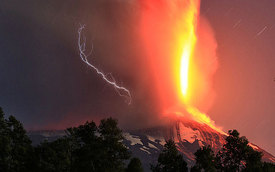 Four years ago today I embarked into the world of online blogging, the topic, volcanoes. Since then, I have finished a masters at Lancaster, spent a year in the real world of work and started a PhD, which incidentally, is nearing completion. Along the way, I have blogged about volcanic trips to Etna, Vulcano and Stromboli; conferences in Japan (including a fortuitous eruption of Sakurajima!), Vienna, San Francisco, Edinburgh and Norwich. What a few years it has been! Of course, any blog scientific blog wouldn't be complete without discussion of my own research and a little bit of fun - impressions of David Attenborough and exploding duck bins - the latter courtesy of the VMSG conference in Edinburgh. A lot of this couldn't have been possible without a number of people (who know who they are!). Blogging has certainly been easier with a lot to write about. Over the past four years I have gained inspiration on blogging topics from my own work and experiences, to the thoughts of fellow online bloggers. One thing is for sure I have thoroughly enjoyed blogging, being involved in the volcanic community and the opportunity to take part in adding to research in the field. Here's to many more years of blogging to come (and hopefully a job at some point...).  Activity at Villarica on Monday 3rd March 2015. Activity at Villarica on Monday 3rd March 2015. A recent period of unrest at Villarica developed spectacularly on the morning of the 3rd of March with a transition to lava fountaining. This eruptive episode has been covered extensively in the media because of the fantastic display and successful evacuation of nearby residents. Usually, Villarica has a relatively stable lava lake at the summit, with occasional mild strombolian activity. Occasionally, the volcano sees more vigorous periods of activity, such as that which occurred on the 3rd of March. One of the major questions surrounding all volcanic activity is: what controls the transitions between different styles of activity? This applies both on longer timescales of years to decades and even centuries but also on shorter ones of seconds to minutes and hours. The latter consideration is my particular area of interest. In a video of activity leading up to the main lava fountain (see video half way down the page), we can see that smaller strombolian like explosions seem to increase in frequency and vigor leading up to the lava fountain (indeed patterns have been noticed in strombolian activity at Etna - a shameless plug of some of my own work). Could this pattern be analysed to predict the occurrence of a lava fountain before it occurs? How could we do this? The answer lies in monitoring gas emissions - a difficult task at night and during more ash rich eruptions! The transition between strombolian type activity and Hawaiian occurs when magma rise speed is high enough such that it prevents the coalescence of bubbles (which are rising at a slower rate than the magma) which drive strombolian style activity when bubbles grow to a large enough size(see this paper by Parfitt and Wilson). |
Archives
July 2023
|

 RSS Feed
RSS Feed